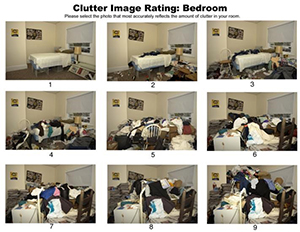Hoarding and Pests: Researchers See Link
 |
|
The CIR scale was created by the Hoarding Center of the International Obsessive Compulsive Disorder Foundation to better diagnose and classify symptoms of hoarding. |
Hoarding disorder occurs in an estimated two to five percent of the population, according to the American Psychiatric Association. Affected individuals excessively save items and have persistent difficulty parting with possessions. Resulting clutter disrupts work and living spaces and creates health and fire hazards. Hoarding also creates environments favorable to pest infestations.
Nearly one in twenty residents of the Boston Housing Authority (BHA) have excessive clutter or hoarding issues, according to program coordinator John Kane. This number is consistent with the psychiatric association’s national statistics.
“Property Managers were seeing hoarding but had no great way to respond,” said Kane.
With funding from the Northeastern IPM Center, BHA led a team of researchers to look closer at levels of clutter and incidences of pest infestations. After reviewing nearly 9,000 inspection forms and control reports and surveying 1,619 units, they found that among the five percent of residents with hoarding issues, pest visits were more than doubled.
Kane trained his staff to use a “clutter image rating scale” (CIR) during housekeeping inspections and identified clutter issues, including improvements.
The team developed a plan to help residents assess situations, set goals, enhance motivation, reduce harm, plan safety measures, organize, solve problems, and to sort and make decisions. Staff also provided resources and referrals. Residents with hoarding behaviors who participated in weekly intervention training reduced their CIR scores by one point or more.
The BHA researchers plan to assess this case management model and intervention plan. They also will conduct staff training and offer a webinar in collaboration with the Center’s StopPests in Housing Program to train a wider audience on reducing hoarding in affordable housing.
One of the basic premises of integrated pest management is preventing a pest infestation before it starts. Kane and his team hope to provide guidance on helping individuals navigate a social and psychological condition, like hoarding, something not often thought of as a barrier to integrated pest management.
— by SUSANNAH REESE
The Northeastern IPM Center promotes integrated pest management for reducing risks to human health and the environment. If republishing our news, please acknowledge the source (“From Northeast IPM Insights”) along with a link to our website.
